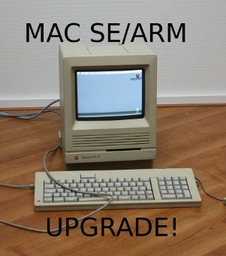Intro

While I still am quite happy with the Macintosh SE/arm casemod I did, as a server it has been a bit lacking recently. As you may remember, the Mac SE/arm basically is a Seagate Dockstar, which is an ARM-based embedded board running Linux, with some USB-peripherials stowed away in a Mac SE/30 casing. While the Dockstar is a really nifty device for the price I got it for, it only has 128MB of RAM and no SATA-ports, meaning any HDs should be connected to it over USB-to-SATA-converters, slowing the speed to the HDs down needlessly.
The problem with these kinds of embedded devices is that it usually isn't really possible to upgrade the RAM or the motherboard, like you can do with a normal x86-based server. So, I've been looking for alternative ARM-devices with enough CPU-power, a bit more RAM than I have now, and real SATA-ports. Unfortunately, most devices didn't qualify: no SATA, too expensive, not enough RAM, ... until I found a cheap HP T5325 thin client.
These HP thin clients basically are embedded devices running a variant of Debian Linux, booting into some proprietary HP tools but otherwise quite vanilla. It's actually possible to turn it into a Debian-running fat client without opening the box or erasing the existing OS. They have an XGI Volari GPU connected to the 1.2GHz Marvell Kirkwood ARM-based CPU, 512M of memory, pads for a SATA-connector, USB-ports up the wazoo, and I could get one for about 60 euro. Perfect!
...And then the unit actually arrived. It was indeed a nice beast, but somehow I've overlooked the fact that the network port only was 100MBit. That is a shame: nowadays, an 100MBit uplink has a noticable difference in speed compared to an 1GBit link. Perhaps this was something that could be fixed, though.
1 Next »